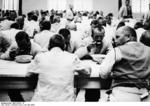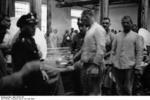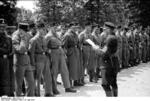Dachau Concentration Camp
| Type | 54 Prison Camp | |
| Historical Name of Location | Dachau, München-Oberbayern, Germany | |
| Coordinates | 48.268889000, 11.468611000 |
Contributor: C. Peter Chen
ww2dbaseIn Mar 1933, Heinrich Himmler began to arrange the conversion of an unused gunpowder and munitions factory about 16 kilometers (about 10 miles) northwest of München (English: Munich) in southern Germany for use as a prison for political prisoners. Such operations began later in the same month with the arrival of about 200 prisoners from Stadelheim Prison in München and the Landsberg Prison in Landsberg am Lech, making it the first Nazi concentration camp; most of these first prisoners were socialists, communists, and other "enemies of the state". The camp was about 300 meters by 600 meters (about 1,000 feet by 2,000 feet) in size. The entrance gate was adorned with the motto "Arbeit macht frei" ("work makes you free"), which indicated the camp's stated purpose as a forced labor camp. After the expansion that took place between early 1937 and Aug 1938, which increased the capacity from 5,000 prisoners to 6,000 prisoners, the camp consisted of 32 prisoner barracks (one of which reserved for the clergy and another reserved for human experiments), a parade ground/execution ground, and a kitchen. The camp was heavily guarded by personnel of the Schutzstaffel (SS). All of the guards were male until 1944 when 19 female guards were introduced to guard the female prisoners transferred from the Auschwitz-Birkenau Concentration Camp in occupied Poland (more details below). Assisting the guards were such installations as 7 guard towers, a 3-meter-wide (10-foot-wide) open strip of land covered by machine guns, and an electrified barb wire fence. A 2.4-meter-wide (about 8-foot-wide) creek, over a meter (about 4 feet) deep at the deepest, guarded the west side of the camp ground. As other concentration camps were established elsewhere in Germany, Dachau became the main training center for the SS organization to train camp guards. Training facilities were located on a larger tract of land adjacent of the main camp. The training facilities included buildings for leadership schools, buildings for a medical school, canteen, library, infirmary, barracks, and factories; some of these buildings were partially staffed by prisoners of the camp, working as servants at the canteen and medical orderlies at the infirmary, for example.
ww2dbaseIn 1935, Jews, Jehovah's Witnesses, homosexuals, common criminals, and various other groups began to arrive at Dachau as prisoners in larger numbers, and quickly diminished political prisoners to a minority. In the aftermath of Kristallnacht in Nov 1938, the camp population swelled by 10,000. In 1939, as German borders grew, the prison population began to include foreign nationals, ie. those from Austria and Czechoslovakia. In 1940, Polish prisoners began to arrive; from this point on, Polish nationals would constitute the majority of the camp population until the camp's closure in 1945. In 1941, Soviet prisoners of war began to arrive. Between late 1941 and 1943, over 4,000 Soviet prisoners of war were killed, in violation of international law (ie. the Geneva Convention). From this point on, the population of the camp regularly exceeded 12,000. In 1942, a crematorium was constructed to aid in the disposal of the dead. In 1944, a women's camp opened at Dachau, taking in a group of female prisoners sent from Auschwitz-Birkenau in occupied Poland. While the prisoners were mistreated from the onset, the worst took place in 1945, which saw the death of 11,560 (from US Army report) or 12,596 (from Dachau camp records) prisoners within about five months' time. This brought the total death occurred at Dachau between Mar 1933 to 24 Apr 1945 to 31,951 at the main Dachau camp plus thousands more in Dachau's 123 sub camps. A total of 206,206 people entered Dachau during its 12-year period of operation.
ww2dbaseThe 123 sub camps of Dachau were established starting in 1943. 11 of them were named Kaufering, distinguished by a number at the end of each; all Kaufering sub camps were established for the construction of underground armament factories (Project Ringeltaube).
ww2dbaseSS medical doctor Sigmund Rascher was in charge of the human experimentation at Dachau during the camp's operation. Hypothermia experiments involved exposure to vats of icy water or being strapped down naked outdoors in freezing temperatures; attempts at reviving the subjects included scalding baths and forcing naked women to copulate with the unconscious victim. Nearly 100 prisoners died during these experiments. High altitude experiments subjected victims to rapid decompression from pressures found at 4,300 meters (14,100 feet) under the sea, causing the victims to experience spasmodic convulsions, agonal breathing, and death. Original records of the experiments were destroyed in the final days of the camp, but communications records between Rascher's staff and Himmler's staff confirms that the human experimentations had taken place.
ww2dbaseOn 24 Apr 1945, as American troops neared, the camp commandant ordered surviving prisoners to leave Dachau. 6,000 to 7,000 prisoners embarked on a forced march southwards to Eurasburg, where they would turn east toward the Tegernsee; the six-day march would result in the death of more than a thousand, caused by exhaustion, hunger, exposure, and execution by camp guards; months later, a mass grave containing 1,071 prisoners would be discovered along the route of the march. An additional 3,000 prisoners were sent out of the camp by vehicles or trains. American troops arrived at Dachau on 29 Apr 1945, liberating 30,000 prisoners. Despite the liberation, deaths due to disease and general weak condition of the prisoners continued, although the situation would improve over time. A number of camp guards were killed during and after the liberation, some in combat, some in revenge killings. An official report coming out of a US Army investigation, published under the title of "American Army Investigation of Alleged Mistreatment of German Guards at Dachau", concluded that between 29 Apr and 8 May 1945, 21 guards in uniform plus a number of guards out of uniform were killed by US Army personnel, while liberated prisoners killed 25 to 50 guards. Colonel Charles L. Decker, an acting deputy judge advocate in the US Army, concluded in late 1945 that, while war crimes had been committed by Americans at Dachau, "there was no such systematic criminality among United States forces as pervaded the Nazi groups in Germany."
ww2dbaseDue to the high number of sub-camps, a number of US units shared the credit as being the liberators of Dachau. These units include 4th Infantry Division, 36th Infantry Division, 42nd Infantry Division, 45th Infantry Division, 63rd Infantry Division, 99th Infantry Division, 103rd Infantry Division, 10th Armored Division, 12th Armored Division, 14th Armored Division, 20th Armored Division, and 101st Airborne Division.
ww2dbaseAfter the prisoners were evacuated, by Oct 1945, Dachau became an internment camp for Germans accused of atrocities while they awaited trials. The main trial against former Dachau personnel was the "United States of America v. Martin Gottfried Weiss et.al." case, in which the 42 accused were tried between Nov and Dec 1945. All of the accused were found guilty, with 36 sentenced to death, including SS-Obersturmbannführer Martin Gottfried Weiss, SS-Obersturmführer Friedrich Wilhelm Ruppert, Dr. Karl Schilling, and Dr. Fritz Hintermeyer; those named were all executed by hanging in May 1946. By Jan 1946, about 18,000 SS personnel and 12,000 Soviet deserters were interned at Dachau. There were several hundred documented cases of prisoner suicide; these were born out of guilt on the part of the Germans and fear of Soviet counter-intelligence agencies on the part of the Soviets. A number of internees were also killed by American and Polish guards in extra-judicial killings.
ww2dbaseAfter 1948, it housed German nationals and ethnic Germans who had been expelled from Czechoslovakia. It also housed American occupation troops, under the name Eastman Barracks, until 1960. Today, some of the structure formerly of Dachau Concentration Camp are being used by the Bereitschaftspolizei anti-riot police force.
ww2dbaseSource: Wikipedia
Last Major Update: Dec 2018
Dachau Concentration Camp Interactive Map
Photographs
 |  |  |  |
Dachau Concentration Camp Timeline
| 20 Mar 1933 | Dachau Concentration Camp was established in Germany by the order of Heinrich Himmler; it was to be guarded by men of the SS. |
| 22 Mar 1933 | Dachau Concentration Camp in southern Germany began operations. SS-Standartenführer Hilmar Wäckerle was named the first commandant. |
| 26 Jun 1933 | SS-Gruppenführer Theodor Eicke was named the commandant of Dachau Concentration Camp in southern Germany, replacing Hilmar Wäckerle. |
| 1 Oct 1933 | SS official Theodor Eicke expanded the punishment directives at Dachau Concentration Camp in Germany; these directives were later applied to all camps until the end of the European War. |
| 4 Jul 1934 | SS-Oberführer Alexander Reiner was named the commandant of Dachau Concentration Camp in southern Germany, replacing Theodor Eicke. |
| 22 Oct 1934 | SS-Brigadeführer Berthold Maack was named the commandant of Dachau Concentration Camp in southern Germany, replacing Alexander Reiner. |
| 12 Jan 1935 | SS-Oberführer Heinrich Deubel was named the commandant of Dachau Concentration Camp in southern Germany, replacing Berthold Maack. |
| 31 Mar 1936 | SS-Oberführer Hans Loritz was named the commandant of Dachau Concentration Camp in southern Germany, replacing Heinrich Deubel. |
| 7 Jan 1939 | SS-Hauptsturmführer Alexander Piorkowski was named the commandant of Dachau Concentration Camp in southern Germany, replacing Hans Loritz. |
| 9 Sep 1939 | German Gestapo ordered all misbehaving Polish citizens to be arrested and placed in Dachau Concentration Camp in southern Germany. |
| 27 Sep 1939 | Dachau Concentration Camp in Germany was temporarily closed until 18 Feb 1940 for use of training SS units; prisoners of Dachau were sent to Mauthausen Concentration Camp. |
| 25 Nov 1941 | The first execution of Soviet prisoners of war at the Dachau Concentration Camp took place at the Hebertshausen shooting range. |
| 3 Jan 1942 | SS-Obersturmbannführer Martin Weiß was named the commandant of Dachau Concentration Camp in southern Germany, replacing Alexander Piorkowski. |
| 1 Sep 1942 | Martin Gottfried Weiss was made the commandant of Dachau Concentration Camp in Germany. |
| 10 Oct 1942 | From Dachau Concentration Camp in Germany, Sigmund Rascher reported his findings from experiments involving putting concentration camp prisoners in full flight suits and placing them in freezing conditions, concluding that the warming of the subjects' heads and necks were vital for the subjects' survival. |
| 30 Sep 1943 | SS-Hauptsturmführer Eduard Weiter was named the commandant of Dachau Concentration Camp in southern Germany, replacing Martin Weiß. |
| 31 Oct 1943 | Martin Gottfried Weiss stepped down as the commandant of Dachau Concentration Camp in Germany. |
| 11 Sep 1944 | Noor Inayat Khan was transferred to Dachau Concentration Camp, Germany. |
| 12 Sep 1944 | Yolande Beekman arrived at Dauchau Concentration Camp in southern Germany. |
| 13 Sep 1944 | Yolande Beekman was executed at Dachau Concentration Camp in southern Germany. |
| 13 Sep 1944 | Noor Inayat Khan was brutally beaten then executed by gunfire in the back of the head at Dachau Concentration Camp, Germany. |
| 1 Nov 1944 | Martin Gottfried Weiss was assigned to oversee the Mühldorf subcamp of Dachau Concentration Camp. |
| 14 Apr 1945 | As Allied troops advanced, Heinrich Himmler ordered all prisoners at Dachau Concentration Camp in southern Germany be exterminated. |
| 19 Apr 1945 | The final transport arrived at Dachau Concentration Camp in southern Germany. |
| 24 Apr 1945 | Dachau Concentration Camp in southern Germany was evacuated. Between 6,000 and 7,000 prisoners embarked on a death march southward to Eurasburg, where they would turn east toward the Tegernsee. Thousands of them would die of exhaustion, hunger, exposure, and execution during the six-day march. |
| 26 Apr 1945 | Over 10,000 prisoners of the Dachau Concentration Camp in southern Germany began to be sent out of the camp. Most of them, just under 7,000 in number, were forced to march on foot southwards. The remainder were evacuate by vehicles or trains. At least 1,071 of those sent out on foot would not survive the evacuation. |
| 27 Apr 1945 | Men of US 12th Armored Division arrived at Kaufering Lager IV in Landsberg am Lech in southern Germany, a sub camp of Dachau Concentration Camp. |
| 28 Apr 1945 | SS-Untersturmführer Johannes Otto was named the commandant of Dachau Concentration Camp in southern Germany, replacing Eduard Weiter. Outside the camp, escapees of the camp and a rebel unit of the Volkssturm staged an armed revolt in the town of Dachau; it was quickly and brutally put down by SS troops. Finally, also on this date, International Red Cross representative Victor Maurer negotiated an agreement for the Germans to surrender Dachau Concentration Camp to US troops. |
| 29 Apr 1945 | SS-Untersturmführer Heinrich Wicker became the final commandant of Dachau Concentration Camp in southern Germany, replacing Johannes Otto, who had been in that role for less than one day. Wicker would share the same fate as his predecessor, as American troops of the 3rd Battalion, 157th Infantry Regiment, US 45th Infantry Division, commanded by Colonel Felix Sparks, would enter Dachau Concentration Camp on this day. Brigadier General Henning Linden of 222nd Infantry Regiment, US 42nd Infantry Division accepted the formal surrender from Wicker. Men of US 157th and 122nd Infantry Regiments were accused of executing a number of German SS prisoners of war, in the camp and in the nearby hamlet of Weßling, before a colonel intervened. |
| 16 Jul 1945 | The US Military Tribunal at Dachau, Germany sentenced Josef Dietrich to life in prison (later commuted to 25 years in prison) for the execution of US prisoners of war at Malmedy, Belgium in 1944. |
| 13 Dec 1945 | 36 of the 42 accused war criminals at the Dachau trial were sentenced to death. |
Please consider supporting us on Patreon. Even $1 per month will go a long way! Thank you. Please help us spread the word: Stay updated with WW2DB: |
Visitor Submitted Comments
30 Apr 2021 07:58:26 PM
To Anonymous of 29 Apr 2021: Thank you for pointing that out. The error has been corrected.
25 Sep 2022 04:40:21 AM
what type of experiments were done on children at dachau? ages 4 to 9
All visitor submitted comments are opinions of those making the submissions and do not reflect views of WW2DB.

Dachau, München-Oberbayern, Germany
Latitude-Longitude:
48.2689, 11.4686
- » 1,181 biographies
- » 337 events
- » 45,132 timeline entries
- » 1,249 ships
- » 350 aircraft models
- » 207 vehicle models
- » 376 weapon models
- » 123 historical documents
- » 261 facilities
- » 470 book reviews
- » 28,427 photos
- » 365 maps
Fleet Admiral Chester W. Nimitz, 16 Mar 1945
Please consider supporting us on Patreon. Even $1 a month will go a long way. Thank you!
Or, please support us by purchasing some WW2DB merchandise at TeeSpring, Thank you!
29 Apr 2021 04:24:34 PM
error 29 Apr 1945 "SS-Untersturmführer Heinrich Wicker became the final commandant of Dachau Concentration Camp in southern Germany, replacing Heinrich Wicker,"
Heinrich Wicker replaced Martin Gottfried Weiss not himself.